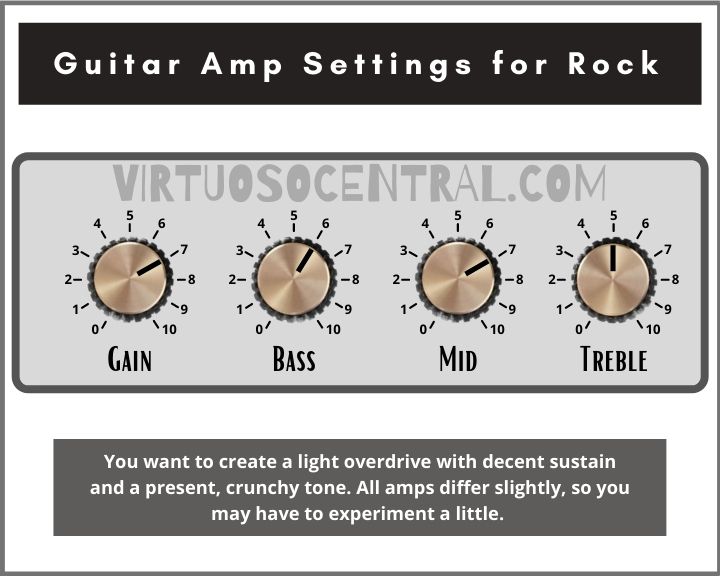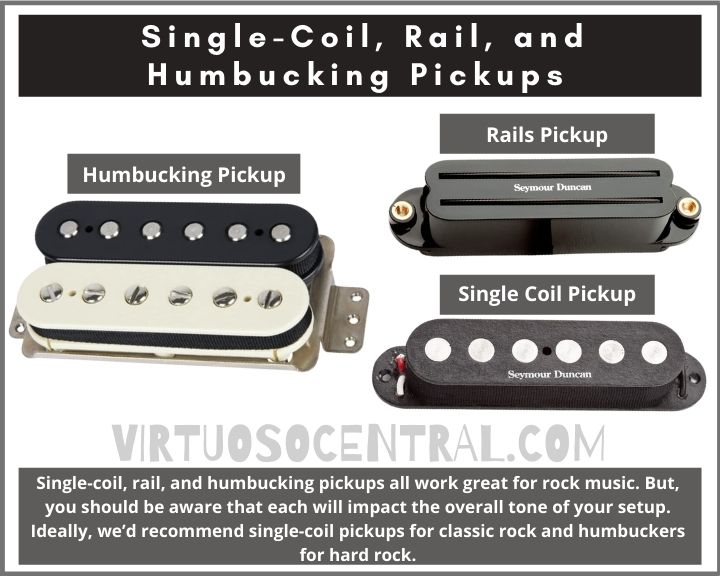Emulating your favorite rock artists with your existing gear can be a challenge. Getting your EQ settings on your amp right can help significantly with this.
Rock music is probably the broadest reaching genre of music with the most sub-genres. Many modern styles of music, such as indie, pop, and even metal, have their roots in rock music.
That makes it difficult to put a lid on exactly what the best amp settings for rock are. As such, we will discuss what you can change to suit your style.
This article will cover all the best guitar amp settings for rock to get you off to a rolling start. Read on to master rock tone on any amp.
A General Starting Point
For the sake of an easy starting point, we want to create a light overdrive with decent sustain and a present, crunchy tone. The following settings will be an excellent place to start for most amplifiers to make such a sound.
- Gain or Drive: +7
- Bass: +5-6
- Mids: +7
- Treble: +5
All amps differ slightly, so you may have to experiment a little. Play a few chords and listen as you play, then adjust one knob at a time. This will allow you to hear how the adjustment impacts your sound.

The Right Amp
Since rock music is so varied, the range of appropriate amps is also huge. If you don’t use pedal or rack effects, it’s a good idea to use an amp with two or more channels so you can switch between tones during your performances.
You could use the separate channels to run one clean and one dirty. You’ll find that many popular rock songs switch to an overdriven channel for choruses. It’s important you’re able to do the same.
You could go for a Vox AC30 or a Marshall Plexi for quality British tone. Fender Hot Rods are the perfect American tone amps for rock. As we mentioned, there’s plenty of variety available. Even if your amp is only good for clean tones, you can use pedals to create an incredible rock sound.
Using Effects
Some amplifiers come with onboard effects that will allow you to build the perfect rock tone. Other times, you’ll have to use stompboxes or rack effects. In any case, here are a few of the essential effects you should consider.
Overdrive
Overdrive is arguably the most critical effect for classic and hard rock. It allows you to create crunchy rhythm lines and push lead lines to soaring new heights. Even if your amp has a decent overdrive channel, you can use an overdrive pedal too. This allows you to introduce different levels of overdrive mid-song.
A classic example of a high-quality overdrive pedal is an Ibanez Tube Screamer.
Distortion
Distortion pedals are often confused with overdrive. Yet, to put it in simple terms, distortion pedals give a hotter output and create a much more saturated and heavy tone. Steer clear of distortion for rock unless you want to play one of its heavier sub-genres.
Fuzz
Fuzz also works similarly to overdrive. Picture fuzz as overdrives little brother. It creates overdriven effects by concentrating on melodic overtones. Generally, it’s less heavy and more bright.
A couple of classic fuzz pedals that deliver excellent overdrive are the Electro-Harmonix Op-amp Big Muff Pi and the Dunlop FFM3 Jimi Hendrix™ Fuzz Face®. Any of these effects will create overdriven melodic overtones.
Reverb
Many high-end vintage amps have reverb built into their clean channels. While it’s okay to use a bit of reverb with overdrive, it can often cause feedback issues.
However, using reverb is necessary to get those clean tones you’re familiar with from plenty of your favorite rock artists like the Rolling Stones.
Delay
Delay comes in several different forms. Tape delay is one of the more favorable types used in rock music. These pedals recreate vintage tape echo machines, so they excel at building a classic rock soundscape.
A digital delay is a more modern approach to the delay effect, which records a sound and replays it at specific intervals that you can adjust. Many guitarists use this type of delay for their lead lines.
Editing Your Guitar Amp Settings for Rock
If you’ve got your amp and effects all sorted, it’s time to start messing with your EQ to get the exact tone you’re after. Let’s take a quick look at what each setting does.
Drive/Gain
This is how hard your tubes get pushed. Solid-state amps recreate the same effect by using discrete components. Therefore, the gain will increase your volume and the saturation of distorted overtones. In short, if the drive is cranked, the amp is overdriven.
To adjust your sound with the drive or gain knob, turn it up to increase the overdrive and down to decrease it.
When using a two-channel amp, you’ll need the gain pulled back on one of the channels to achieve a clean tone. In this case, you should turn the volume knob up on the clean channel to counteract the loss of volume from the drive being set lower. This is especially true for tube amps.
Bass
We suggested setting the bass at around 12 o’clock as a neutral setting in the low end is a good starting point. You don’t want your notes to clash with your bass player, nor do you want the very bottom end of your notes to be the most present part of your playing. This can sound very muddy.
However, you may want to boost the bass a little if you play hard rock to get a better chug from palm-muted strums.
Mids
The middle frequencies are arguably the electric guitar’s best. They don’t have much to contend with within a typical band setting and fill out the overall sound. This is why rock guitarists tend to have the mids boosted a little in the EQ.
Again, if you play a heavier sub-genre of rock, you could choose to scoop them instead to allow for a crisper chug and give room for the treble and bass to shine.
Treble
It’s rarely a good idea to crank the treble settings on your amp to 11. It creates an uncomfortable harshness. Yet, if you feel like the high end lacks a little, or want a little more crispness for your solos, feel free to boost the treble a little.
Be Aware of Your Pickups
Single-coil, rail, and humbucking pickups all work great for rock music. But, you should be aware that each will impact the overall tone of your setup. Ideally, we’d recommend single-coil pickups for classic rock and humbuckers for hard rock.
You should also take note of which pickup position you use most. You might find the perfect amp settings for your bridge pickup, but they won’t work for your neck pickup. It may be a good idea to take note of the settings for each.
The same applies if you use several different guitars. Don’t assume your Les Paul will sound the same as your Stratocaster with the same EQ settings on your amp. Experimentation is key. Just make sure you have done all the experimenting before taking your gear on stage.

Learn More
Although the guitar is often the centerpiece of performance, getting the electric guitar amp settings for rock right doesn’t complete the picture.
Your whole band has to sound on point to get noticed. Luckily, we have plenty of articles dedicated to getting the perfect PA settings. Check out these related articles to help you out.
